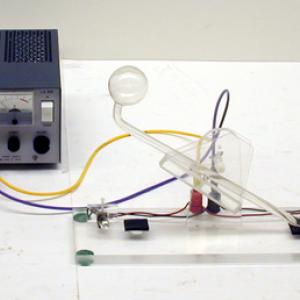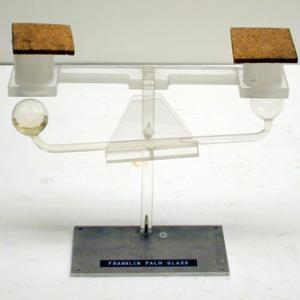College of Liberal Arts & Sciences
4C31.37 - Franklin's Pulse Glass Engine - Relaxation Oscillators
Video Credit: Jonathan M. Sullivan-Wood.
Place the pulse glass on the stand with the two attached light bulbs. Turn the light bulbs on and turn the power supply up to 12 volts. The light bulbs will heat one end of the pulse glass forcing the liquid into the other end. When this happens the other end drops and is heated then by the light bulb on that side. The cycle then repeats.
By putting the pulse glass on the stand you can make this work unattended. Fill the two beakers with liquid nitrogen and cover with the cork plates. The pulse glass will touch one of the beakers and the liquid inside will be condensed in the bulb that is touching. This will cause the pulse glass to shift position and then the other bulb will touch the beaker with the liquid then going to that bulb and so on.
This demonstration is also a good example of a relaxation oscillator.
We have a variety of relaxation oscillators available. Look at these webpages:
3A95.10 - Relaxation Oscillators
6-00.00 - Stroboscope (we have small variable frequency strobe lights available).
2B60.30 - Tantalus Cups
3D32.15 - Stadium Horn
4C30.25 - Geyser
4C31.30 - Drinking Bird
4C31.37 - Franklin's Pulse Glass Engine
5A40.70 - Kelvin Water Dropper
5F30.60 - Relaxation Oscillators - Neon Bulb, Doorbell, and Strobe Lights
10A06.10 - Relaxation Oscillators
13A10.10 - Perpetual Motion
- James Lincoln, "The Hand Boiler and How It Does Not Work", TPT, Vol. 60, #3, March 2022, p. 232.
- Paul Chagnon, "Animated Displays V: Relaxation Oscillators", TPT, Vol. 32, # 7, p. 432- 436, Oct. 1994.
- H- 500: "Palm Glass Oscillator", DICK and RAE Physics Demo Notebook.
- H- 73: Richard Manliffe Sutton, Demonstration Experiments in Physics.
- George M. Hopkins, "Air Thermostat", Experimental Science, p. 185.
- Joseph Frick, "# 360 - The Pulse-Glass", Physical Technics: Or Practical Instructions for Making Experiments in Physics and the Construction of Physical Apparatus with the Most Limmited Means, p. 426.
- The Queen Catalogues Vol. II, Catalogue of Physical Instruments, No. 5033, p. 65.
Disclaimer: These demonstrations are provided only for illustrative use by persons affiliated with The University of Iowa and only under the direction of a trained instructor or physicist. The University of Iowa is not responsible for demonstrations performed by those using their own equipment or who choose to use this reference material for their own purpose. The demonstrations included here are within the public domain and can be found in materials contained in libraries, bookstores, and through electronic sources. Performing all or any portion of any of these demonstrations, with or without revisions not depicted here entails inherent risks. These risks include, without limitation, bodily injury (and possibly death), including risks to health that may be temporary or permanent and that may exacerbate a pre-existing medical condition; and property loss or damage. Anyone performing any part of these demonstrations, even with revisions, knowingly and voluntarily assumes all risks associated with them.

